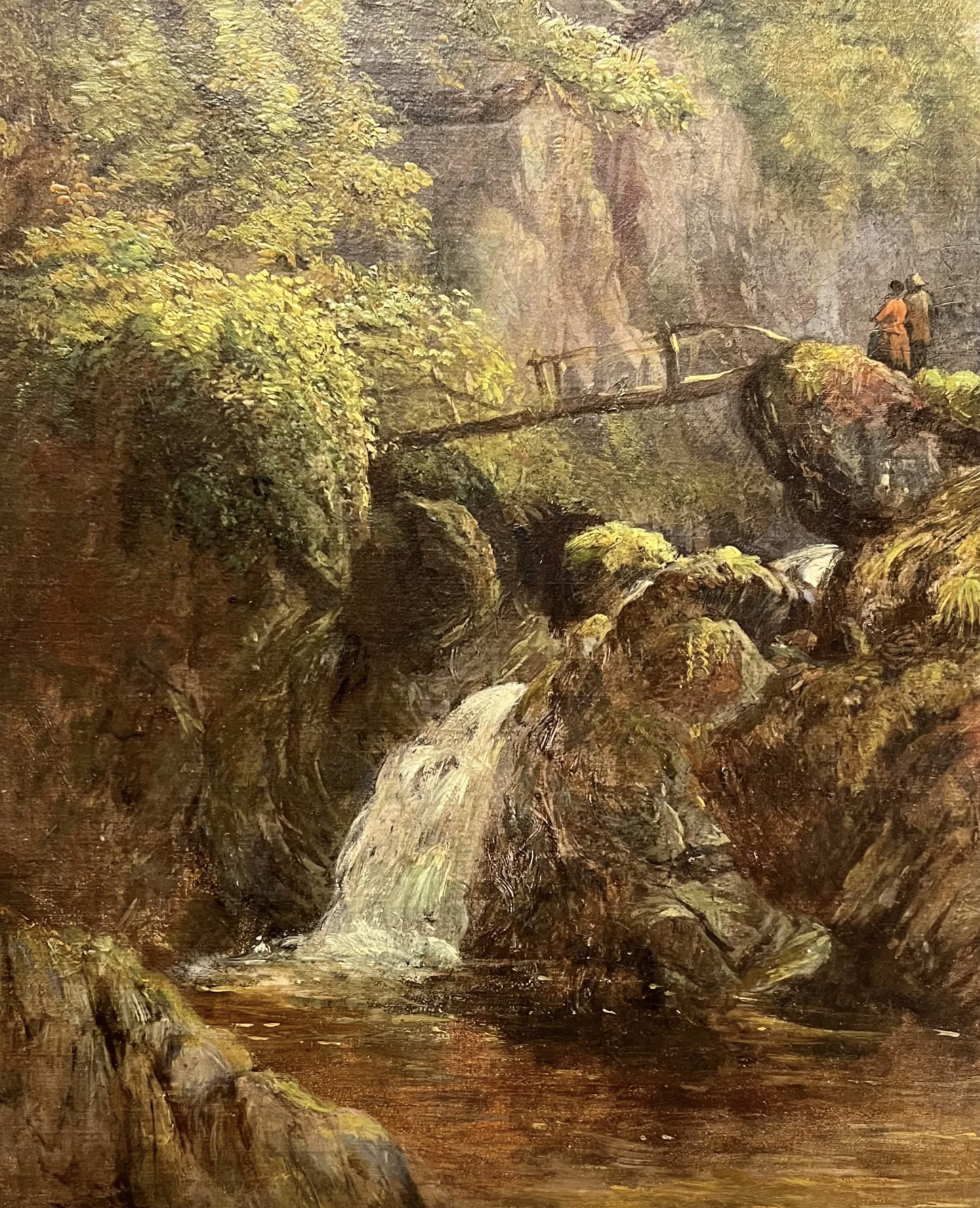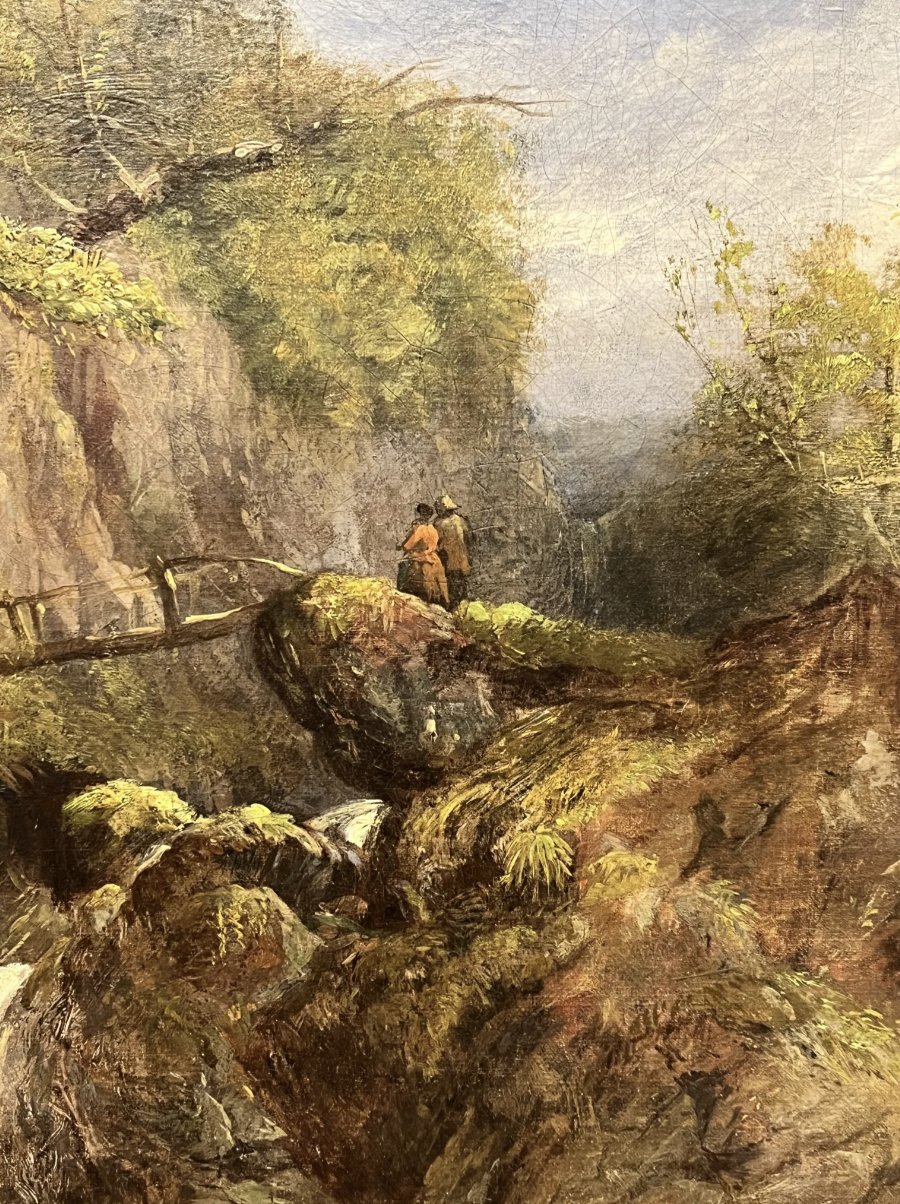 Image 1 of 7
Image 1 of 7

 Image 2 of 7
Image 2 of 7

 Image 3 of 7
Image 3 of 7

 Image 4 of 7
Image 4 of 7

 Image 5 of 7
Image 5 of 7

 Image 6 of 7
Image 6 of 7

 Image 7 of 7
Image 7 of 7








Airey Force, Ullswater, Westmoreland (1863)
Artist: Thomas Moran
Medium: Oil on Canvas
Creation Year: 1865
Dimensions: 22 x 18 inches
Style: Hudson River School
Period: Mid 19th Century
Condition: Excellent
Description: This evocative painting by Thomas Moran (1837–1926) captures both the grandeur of the natural world and the intimate presence of people within it. Known for his sweeping depictions of Yellowstone, the Grand Canyon, and the American West, Moran also painted quieter scenes like Enjoying Westmoreland Falls, where the power of the scene combines with gentle human nature.
In this work, Moran depicts figures at a small, weathered bridge suspended between rocks as the falls and creek surge below. The rustic structure, set against the rushing water, underscores both the beauty and the precariousness of human encounters with nature. Rather than dominating the composition, the people are integrated seamlessly, encouraging viewers to imagine themselves pausing at the falls, listening to the roar of water, and feeling the mist in the air.
Moran’s ability to render water, rock, and light with atmospheric depth reflects his ties to both the Hudson River School and Romantic landscape traditions. The falls are painted with vigor and luminosity, while the surrounding rocks and foliage balance the scene with earthy solidity. The painting conveys not only Moran’s technical brilliance but also his enduring fascination with the sublime: the mixture of wonder, awe, and humility that nature inspires.
Enjoying Westmoreland Falls is a masterful example of Moran’s gift for capturing moments where humanity and wilderness meet, offering a timeless reminder of the delicate dialogue between people and the natural world.
Artist: Thomas Moran
Medium: Oil on Canvas
Creation Year: 1865
Dimensions: 22 x 18 inches
Style: Hudson River School
Period: Mid 19th Century
Condition: Excellent
Description: This evocative painting by Thomas Moran (1837–1926) captures both the grandeur of the natural world and the intimate presence of people within it. Known for his sweeping depictions of Yellowstone, the Grand Canyon, and the American West, Moran also painted quieter scenes like Enjoying Westmoreland Falls, where the power of the scene combines with gentle human nature.
In this work, Moran depicts figures at a small, weathered bridge suspended between rocks as the falls and creek surge below. The rustic structure, set against the rushing water, underscores both the beauty and the precariousness of human encounters with nature. Rather than dominating the composition, the people are integrated seamlessly, encouraging viewers to imagine themselves pausing at the falls, listening to the roar of water, and feeling the mist in the air.
Moran’s ability to render water, rock, and light with atmospheric depth reflects his ties to both the Hudson River School and Romantic landscape traditions. The falls are painted with vigor and luminosity, while the surrounding rocks and foliage balance the scene with earthy solidity. The painting conveys not only Moran’s technical brilliance but also his enduring fascination with the sublime: the mixture of wonder, awe, and humility that nature inspires.
Enjoying Westmoreland Falls is a masterful example of Moran’s gift for capturing moments where humanity and wilderness meet, offering a timeless reminder of the delicate dialogue between people and the natural world.
